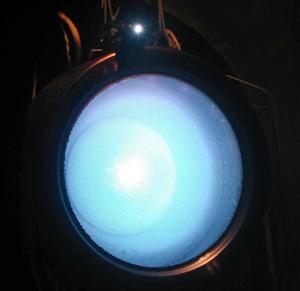Mon, Jul 01, 2013
Advanced Ion Engine Has Run Continuously for 48,000 Hours
A NASA advanced ion propulsion engine has successfully operated for more than 48,000 hours, or 5 and a half years, making it the longest test duration of any type of space propulsion system demonstration project ever. The thruster was developed under NASA's Evolutionary Xenon Thruster (NEXT) Project at NASA's Glenn Research Center in Cleveland. Glenn manufactured the test engine's core ionization chamber. Aerojet Rocketdyne of Sacramento, CA, designed and built the ion acceleration assembly.

The 7-kilowatt class thruster could be used in a wide range of science missions, including deep space missions identified in NASA's Planetary Science Decadal Survey. "The NEXT thruster operated for more than 48,000 hours," said Michael J. Patterson, principal investigator for NEXT at Glenn. "We will voluntarily terminate this test at the end of this month, with the thruster fully operational. Life and performance have exceeded the requirements for any anticipated science mission."
The NEXT engine is a type of solar electric propulsion in which thruster systems use the electricity generated by the spacecraft's solar panel to accelerate the xenon propellant to speeds of up to 90,000 mph. This provides a dramatic improvement in performance compared to conventional chemical rocket engines. During the endurance test performed in a high vacuum test chamber at Glenn, the engine consumed about 1,918 pounds of xenon propellant, providing an amount of total impulse that would take more than 22,000 pounds of conventional rocket propellant for comparable applications.
"Aerojet Rocketdyne fully supports NASA's vision to develop high power solar electric propulsion for future exploration," said Julie Van Kleeck, Aerojet Rocketdyne's vice president for space advanced programs. "NASA-developed next generation high power solar electric propulsion systems will enhance our nation's ability to perform future science and human exploration missions."
(NEXT ion thruster image provided by NASA.)
More News
From 2023 (YouTube Version): Legacy of a Titan Robert (Bob) Anderson Hoover was a fighter pilot, test pilot, flight instructor, and air show superstar. More so, Bob Hoover was an i>[...]
Get The Latest in Aviation News NOW on Instagram Are you on Instagram yet? It's been around for a few years, quietly picking up traction mostly thanks to everybody's new obsession >[...]
Aero Linx: B-52H Stratofortress The B-52H Stratofortress is a long-range, heavy bomber that can perform a variety of missions. The bomber is capable of flying at high subsonic spee>[...]
Altimeter Setting The barometric pressure reading used to adjust a pressure altimeter for variations in existing atmospheric pressure or to the standard altimeter setting (29.92).>[...]
"Knowing that we play an active part in bettering people's lives is extremely rewarding. My team and I are very thankful for the opportunity to be here and to help in any way we ca>[...]
 Classic Aero-TV: Remembering Bob Hoover
Classic Aero-TV: Remembering Bob Hoover ANN FAQ: Follow Us On Instagram!
ANN FAQ: Follow Us On Instagram! ANN's Daily Aero-Linx (05.15.24)
ANN's Daily Aero-Linx (05.15.24) ANN's Daily Aero-Term (05.15.24):Altimeter Setting
ANN's Daily Aero-Term (05.15.24):Altimeter Setting Aero-News: Quote of the Day (05.16.24)
Aero-News: Quote of the Day (05.16.24)



